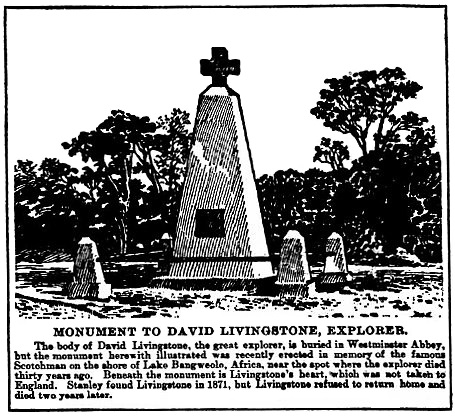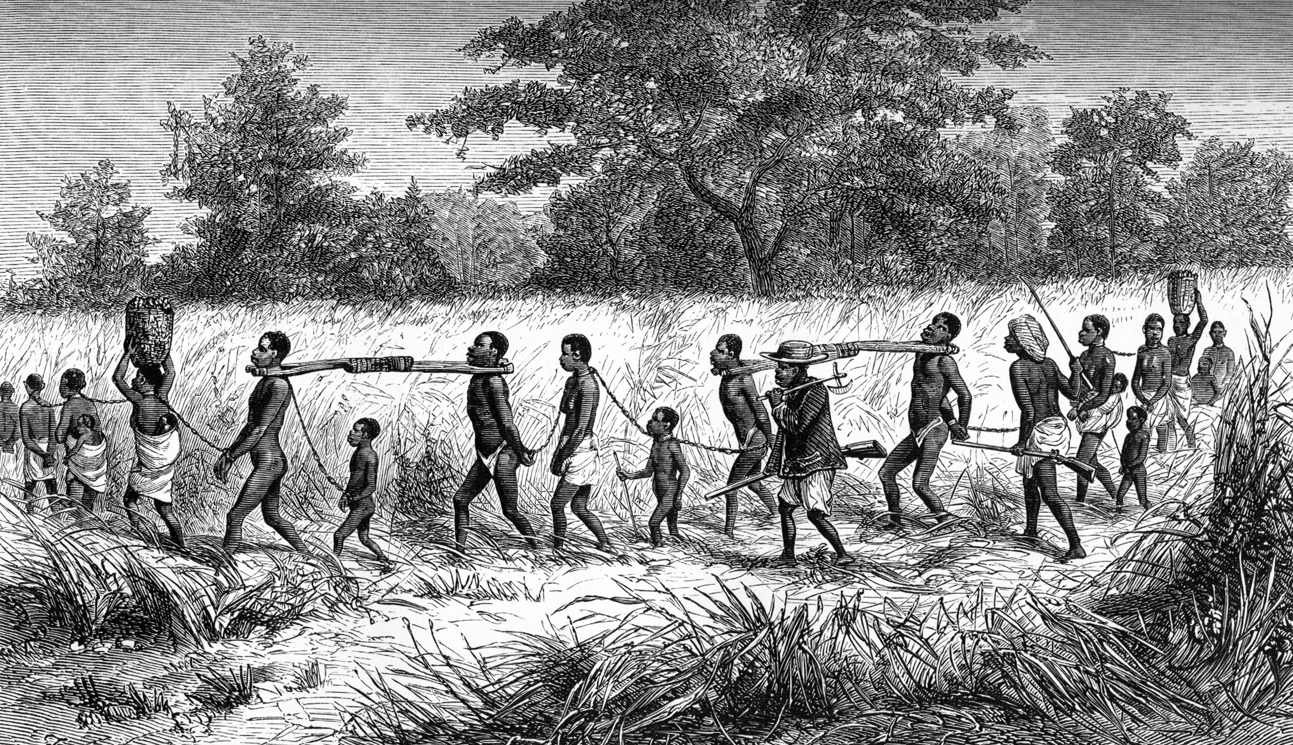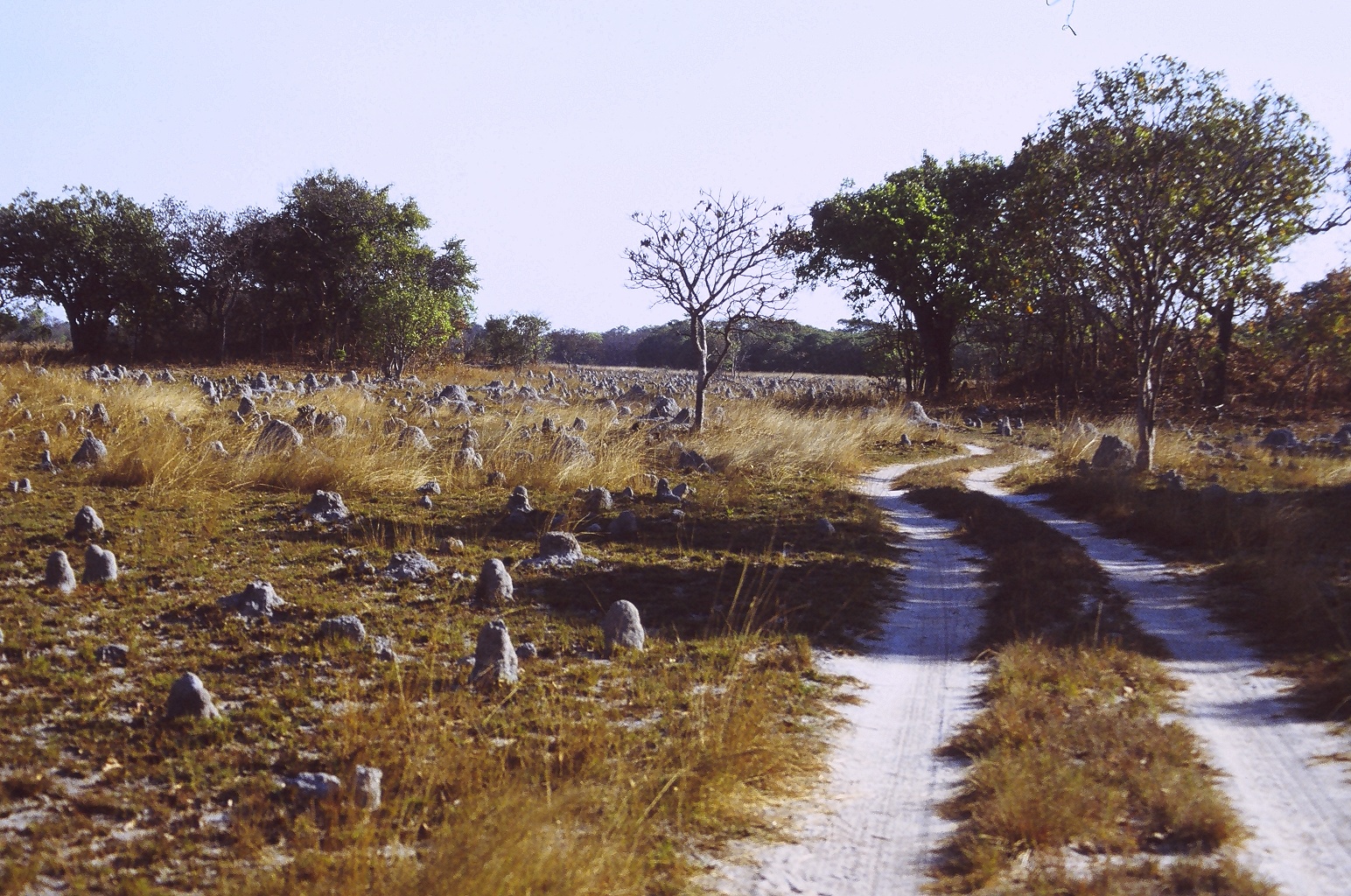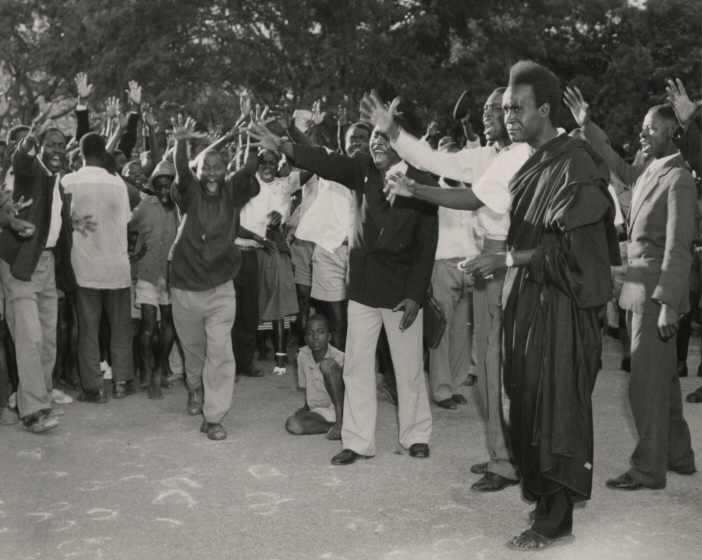|
Chitambo
The Livingstone Memorial, built in 1899, marks the spot where missionary explorer David Livingstone died on 1 May 1873, in Chief Chitambo's village at Chipundu (today in Chitambo District), near the edge of the Bangweulu Swamps in Zambia. His body was embalmed and his heart was buried there under a mpundu tree by his followers, now led by his loyal attendants Chuma and Susi, who then departed for the coast carrying his body. In their party was an Indian-educated African man named Jacob Wainwright who carved the inscription "LIVINGSTONE MAY 4 1873" and the names of the attendants on the tree.J Desmond Clark: "David Livingstone Memorial at Chitambo's", ''The Northern Rhodesia Journal'', Vol 1 No 1, 1950. The fate of the memorial tree By 1899, Chitambo's village had dispersed to another site after the death of the chief, and the tree was decaying. It was cut down by Robert Codrington who had been sent by the British Commissioner Alfred Sharpe to prepare the way for a permanent memo ... [...More Info...] [...Related Items...] OR: [Wikipedia] [Google] [Baidu] |
Chitambo District
Chitambo District is a district of Central Province, Zambia. It was separated from Serenje District in 2012 and is located some 357km north-east of Kabwe along the Great North Road. It shares borders with Serenje, Samfya (Luapula Province), Lavushimanda (Muchinga Province) and the Democratic Republic of Congo. The Livingstone Memorial The Livingstone Memorial, built in 1899, marks the spot where missionary explorer David Livingstone died on 1 May 1873, in Chief Chitambo's village at Chipundu (today in Chitambo District), near the edge of the Bangweulu Swamps in Zambia. His bod ... is located within this district. Agriculture and Agro-processing Chitambo District has a very good rainfall distribution throughout the rain season, favoring agriculture production. In addition, the district soil profile supports crop agriculture, especially leguminous crops such as beans, soya beans and pigeon peas. Other crops that have high potential and are grown in the district include; finge ... [...More Info...] [...Related Items...] OR: [Wikipedia] [Google] [Baidu] |
Chuma And Susi
James Chuma and Abdullah Susi were people from central Africa who took part in the second Zambesi expedition led by the explorer David Livingstone, and were employed by him in his last expedition. They had significant roles in organisation, and were the first to greet Henry Morton Stanley, Stanley when his search party made contact. They supported Livingstone on his last travels, and after his death played a leading role in taking his body to the coast for return to Britain. In 1874 they went to Britain, visiting his family and friend and benefactor James Young (chemist), James Young, and helped Horace Waller (activist), Horace Waller with his task of transcribing and editing ''The Last Journals of David Livingstone in Central Africa'', contributing their own memories for notes of clarification and for the period after Livingstone's last journal entry. Background David Livingstone, missionary physician, doctor, explored the Zambezi and crossed the continent to Luanda. He was fl ... [...More Info...] [...Related Items...] OR: [Wikipedia] [Google] [Baidu] |
David Livingstone
David Livingstone (; 19 March 1813 – 1 May 1873) was a Scottish physician, Congregationalist, and pioneer Christian missionary with the London Missionary Society, an explorer in Africa, and one of the most popular British heroes of the late 19th-century Victorian era. David was the husband of Mary Moffat Livingstone, from the prominent 18th Century missionary family, Moffat. He had a mythic status that operated on a number of interconnected levels: Protestant missionary martyr, working-class "rags-to-riches" inspirational story, scientific investigator and explorer, imperial reformer, anti-slavery crusader, and advocate of British commercial and colonial expansion. Livingstone's fame as an explorer and his obsession with learning the sources of the Nile River was founded on the belief that if he could solve that age-old mystery, his fame would give him the influence to end the East African Arab–Swahili slave trade. "The Nile sources", he told a friend, "are valuabl ... [...More Info...] [...Related Items...] OR: [Wikipedia] [Google] [Baidu] |
Serenje
Serenje is a town of Serenje District, Zambia, lying just off the Great North Road and TAZARA Railway. Serenje has a railway station on the TAZARA railway. Serenje is approximately 191 km from Kapiri Mposhi on the Great North Road. Mkushi is the district west of Serenje. The Mulembo Falls lie near the town. Economy The inhabitants of Serenje district engage in subsistence agriculture. Though the area is blessed with rich soils and thick forests, economic development appears to have eluded this Zambian rural outpost. Society Serenje is home to the Lala people whose primary language is ciLala. The Lala language, like most languages spoken on the Copperbelt and Central provinces of Zambia, is classified as belonging to the Bemba language group. The Lala people, like most ethnic groups in central and northern and northwestern parts of Zambia, are said to have descended from the Luba-Lunda Kingdom in present-day Congo DRC. Serenje district is constituted by a number of Chie ... [...More Info...] [...Related Items...] OR: [Wikipedia] [Google] [Baidu] |
Lake Bangweulu
Bangweulu — 'where the water sky meets the sky' — is one of the world's great wetland systems, comprising Lake Bangweulu, the Bangweulu Swamps and the Bangweulu Flats or floodplain.Camerapix: ''Spectrum Guide to Zambia.'' Camerapix International Publishing, Nairobi, 1996. Situated in the upper Congo River basin in Zambia, the Bangweulu system covers an almost completely flat area roughly the size of Connecticut or East Anglia, at an elevation of 1,140 m straddling Zambia's Luapula Province and Northern Province. It is crucial to the economy and biodiversity of northern Zambia, and to the birdlife of a much larger region, and faces environmental stress and conservation issues.Halls, A.J. (ed.), 1997. "Wetlands, Biodiversity and the Ramsar Convention: The Role of the Convention on Wetlands in the Conservation and Wise Use of Biodiversity". Ramsar Convention Bureau, Gland, Switzerland With a long axis of 75 km and a width of up to 40 km, Lake Bangweulu's permanent open ... [...More Info...] [...Related Items...] OR: [Wikipedia] [Google] [Baidu] |
Kasanka National Park
Kasanka National Park is a park located in the Chitambo District of Zambia’s Central Province, Zambia, Central Province. At roughly , Kasanka is one of Zambia’s smallest national parks. Kasanka was the first of Zambia’s national parks to be managed by a private-public partnership. The privately funded Kasanka Trust Ltd has been in operation since 1986 and undertakes all management responsibilities, in partnership with the Department of National Parks and Wildlife (DNPW - previously ZAWA). The park has an average elevation between and above mean sea level. It has a number permanent shallow lakes and water bodies with the largest being Wasa. There are five perennial rivers in the park, with the largest being the Luwombwa River. The Luwombwa is the only river that drains the NP, which flows out in the northwestern corner. It is a tributary of the Luapula, which further upstream also drains the Bangweulu Swamp and forms the main source of the Congo River. Although Kasanka NP ... [...More Info...] [...Related Items...] OR: [Wikipedia] [Google] [Baidu] |
Monuments And Memorials In Zambia
A monument is a type of structure that was explicitly created to commemorate a person or event, or which has become relevant to a social group as a part of their remembrance of historic times or cultural heritage, due to its artistic, historical, political, technical or architectural importance. Some of the first monuments were dolmens or menhirs, megalithic constructions built for religious or funerary purposes. Examples of monuments include statues, (war) memorials, historical buildings, archaeological sites, and cultural assets. If there is a public interest in its preservation, a monument can for example be listed as a UNESCO World Heritage Site. Etymology It is believed that the origin of the word "monument" comes from the Greek ''mnemosynon'' and the Latin ''moneo'', ''monere'', which means 'to remind', 'to advise' or 'to warn', however, it is also believed that the word monument originates from an Albanian word 'mani men' which in Albanian language means 'rememb ... [...More Info...] [...Related Items...] OR: [Wikipedia] [Google] [Baidu] |
History Of Zambia
The history of Zambia experienced many stages from colonization to independence from Britain on October 24, 1964. Northern Rhodesia became a British sphere of influence in the present-day region of Zambia in 1888, and was officially proclaimed a British protectorate in 1924. After many years of suggested mergers, Southern Rhodesia, Northern Rhodesia, and Nyasaland were merged into the British Federation of Rhodesia and Nyasaland. By 1960, British Prime Minister, Harold Macmillan, declared that the age of colonial rule in Africa was ending. Finally, in December 1963, the federation was dissolved, and the Republic of Zambia was formed out of Northern Rhodesia on October 24, 1964. History Prehistoric era Archaeological excavation work on the Zambezi Valley and Kalambo Falls show a succession of human cultures. In particular, ancient camping site tools near the Kalambo Falls have been radiocarbon dated to more than 36,000 years ago. The fossil skull remains of Broken Hill Man, da ... [...More Info...] [...Related Items...] OR: [Wikipedia] [Google] [Baidu] |
Kenneth Kaunda
Kenneth David Kaunda (28 April 1924 – 17 June 2021), also known as KK, was a Zambian politician who served as the first President of Zambia from 1964 to 1991. He was at the forefront of the struggle for independence from British rule. Dissatisfied with Harry Nkumbula's leadership of the Northern Rhodesian African National Congress, he broke away and founded the Zambian African National Congress, later becoming the head of the socialist United National Independence Party (UNIP). Kaunda was the first president of independent Zambia. In 1973, following tribal and inter-party violence, all political parties except UNIP were banned through an amendment of the constitution after the signing of the Choma Declaration. At the same time, Kaunda oversaw the acquisition of majority stakes in key foreign-owned companies. The 1973 oil crisis and a slump in export revenues put Zambia in a state of economic crisis. International pressure forced Kaunda to change the rules that had kept him i ... [...More Info...] [...Related Items...] OR: [Wikipedia] [Google] [Baidu] |
The Rhodesias
Rhodesia, known initially as Zambesia, is a historical region in southern Africa whose formal boundaries evolved between the 1890s and 1980. Demarcated and named by the British South Africa Company (BSAC), which governed it until the 1920s, it thereafter saw administration by various authorities. It was bisected by a natural border, the Zambezi. The territory to the north of the Zambezi was officially designated Northern Rhodesia by the company, and has been Zambia since 1964; that to the south, which the company dubbed Southern Rhodesia, became Zimbabwe in 1980. Northern and Southern Rhodesia were sometimes informally called "the Rhodesias". The term "Rhodesia" was first used to refer to the region by White settlers in the 1890s who informally named their new home after Cecil Rhodes, the company's founder and managing director. It was used in newspapers from 1891 and was made official by the company in 1895. To confuse matters, Southern Rhodesia, which became a self-governi ... [...More Info...] [...Related Items...] OR: [Wikipedia] [Google] [Baidu] |
Lozi People
Lozi people, or Barotse, are a southern African ethnic group who speak Lozi or Silozi, a Sotho–Tswana language. The Lozi people consist of more than 46 different ethnic groups and are primarily situated between Namibia, Angola, Botswana, Zimbabwe including half of eastern and northern province of Zambia inhabiting the region of Barotseland. Lozi is also a nationality of the people of Barotseland, an amalgamation of several smaller ethnic groups and tribes. The Lozi people number approximately 5,575,000. Lozi are also found in Zambia, Namibia (Caprivi Strip), Angola, Botswana, Mozambique (50,000), and Zimbabwe (8,000). The Lozi are also known as the Malozi, Nyambe, Makololo, Barotose, Rotse, Rozi, Rutse, Baloyi, Balobedu or Tozvi. Name The word Lozi means 'plain' in the Makololo language, in reference to the Barotse Floodplain of the Zambezi on and around which most Lozi live. It may also be spelled Lotse or Rotse, the spelling Lozi having originated with German missionaries in ... [...More Info...] [...Related Items...] OR: [Wikipedia] [Google] [Baidu] |
Barotseland
Barotseland ( Lozi: Mubuso Bulozi) is a region between Namibia, Angola, Botswana, Zimbabwe including half of eastern and northern provinces of Zambia and the whole of Democratic Republic of Congo's Katanga Province. It is the homeland of the Lozi people or ''Barotse'', or Malozi, who are a unified group of over 46 individual formerly diverse tribes related through kinship, whose original branch are the Luyi (Maluyi), and also assimilated Southern Sotho tribe of South Africa known as the Makololo. The Barotse speak Silozi, a language most closely related to Sesotho. Barotseland covers an area of 252,386 square kilometres, but is estimated to have been twice as large at certain points in its history. Once an empire, the Kingdom stretched into Namibia, Angola, Botswana, Zimbabwe including half of eastern and northern provinces of Zambia and the Democratic Republic of Congo's Katanga Province. Under the British colonial administration, Barotseland was a Protectorate of the Briti ... [...More Info...] [...Related Items...] OR: [Wikipedia] [Google] [Baidu] |









